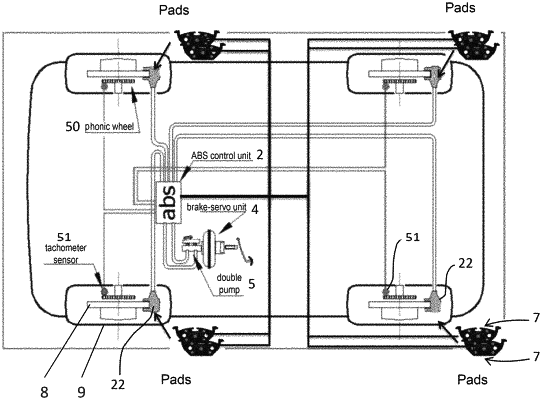| CPC B60T 8/52 (2013.01) [B60T 8/171 (2013.01); B60T 8/172 (2013.01); B60T 8/17616 (2013.01); B60T 8/17636 (2013.01); F16D 65/092 (2013.01); F16D 66/00 (2013.01); B60T 2210/124 (2013.01); F16D 2066/005 (2013.01)] | 17 Claims |

|
1. A system configured to control braking of a wheel of a set of wheels of a vehicle, the system comprising:
a sensorized brake pad configured to be applied against a brake disk associated with the wheel of the vehicle during a braking application, the sensorized brake pad comprising:
a support element;
a friction material attached to the support element; and
a force sensor configured to transmit signals indicative of a force applied to the sensorized brake pad during the braking application; and
a computing system comprising a processor and a non-transitory storage, the computing system configured to:
receive the signals, including one or more first measurements, from the sensorized brake pad;
determine, using the signals from the sensorized brake pad, first anti-lock braking parameters of the wheel associated with the one or more first measurements or one or more predetermined threshold values;
control application of the sensorized brake pad against the brake disk based on the first anti-lock braking parameters;
subsequent to determining the first anti-lock braking parameters, iteratively test to determine whether a tire-road coefficient of friction between a tire of the wheel and a road has changed beyond a threshold amount;
in response to determining that the tire-road coefficient of friction has changed beyond the threshold amount, accessing a lookup table to determine second anti-lock braking parameters of the wheel based at least in part on the tire-road coefficient of friction; and
control application of the sensorized brake pad against the brake disk based on the second anti-lock braking parameters,
wherein the first anti-lock braking parameters include a first braking torque limit of the wheel and a first braking torque limit of at least one other wheel of the set of wheels, and subsequent to determining the first anti-lock braking parameters, performing iterative testing to set a deceleration profile for each wheel of the set of wheels, and set a slippage, speed, or acceleration threshold of each wheel of the set of wheels to maintain the deceleration profile, wherein the iterative testing comprises a coefficient of friction jump test to determine whether a split condition is detected, and wherein the second anti-lock braking parameters of the wheel are set differently than anti-lock braking parameters of another wheel when the split condition is detected.
|